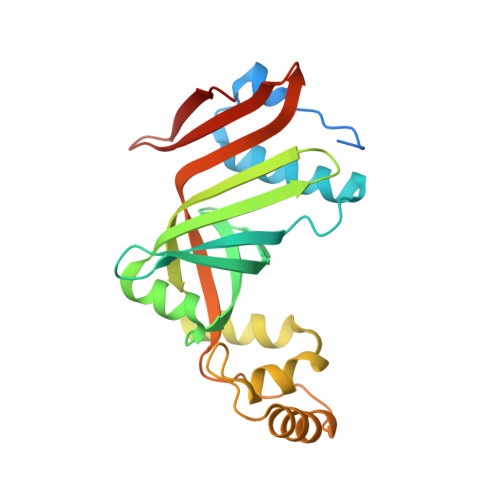Trapped intermediates in crystals of the FMN-dependent oxidase PhzG provide insight into the final steps of phenazine biosynthesis
Xu, N., Ahuja, E.G., Janning, P., Mavrodi, D.V., Thomashow, L.S., Blankenfeldt, W.(2013) Acta Crystallogr D Biol Crystallogr 69: 1403-1413
- PubMed: 23897464
- DOI: https://doi.org/10.1107/S0907444913008354
- Primary Citation of Related Structures:
4HMS, 4HMT, 4HMU, 4HMV, 4HMW, 4HMX - PubMed Abstract:
Phenazines are redox-active secondary metabolites that many bacteria produce and secrete into the environment. They are broad-specificity antibiotics, but also act as virulence and survival factors in infectious diseases. Phenazines are derived from chorismic acid, but important details of their biosynthesis are still unclear. For example, three two-electron oxidations seem to be necessary in the final steps of the pathway, while only one oxidase, the FMN-dependent PhzG, is conserved in the phenazine-biosynthesis phz operon. Here, crystal structures of PhzG from Pseudomonas fluorescens 2-79 and from Burkholderia lata 383 in complex with excess FMN and with the phenazine-biosynthesis intermediates hexahydrophenazine-1,6-dicarboxylate and tetrahydrophenazine-1-carboxylate generated in situ are reported. Corroborated with biochemical data, these complexes demonstrate that PhzG is the terminal enzyme in phenazine biosynthesis and that its relaxed substrate specificity lets it participate in the generation of both phenazine-1,6-dicarboxylic acid (PDC) and phenazine-1-carboxylic acid (PCA). This suggests that competition between flavin-dependent oxidations through PhzG and spontaneous oxidative decarboxylations determines the ratio of PDC, PCA and unsubstituted phenazine as the products of phenazine biosynthesis. Further, the results indicate that PhzG synthesizes phenazines in their reduced form. These reduced molecules, and not the fully aromatized derivatives, are the likely end products in vivo, explaining why only one oxidase is required in the phenazine-biosynthesis pathway.
- Lehrstuhl für Biochemie, Universität Bayreuth, Universitätsstrasse 30, 95447 Bayreuth, Germany.
Organizational Affiliation:


















